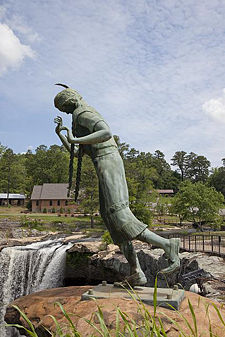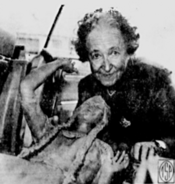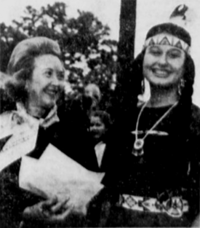Noccalula statue
The Noccalula statue is a 9-foot-tall, 3,000-pound bronze sculpture depicting the Cherokee maiden "Noccalula" at the moment of her legendary leap into the gorge below what is now known as Noccalula Falls at Noccalula Falls Park in Gadsden. It was dedicated in September 1969.
The idea of erecting a statue to the girl was promoted by the Gadsden Woman's Club, which raised $25,000 to complete the project. The sculpture was commissioned from Belgian-born artist Suzanne Silvercruys (1898–1973). She made a small wax model while visiting the park in 1968. Kay Smith of Glencoe modeled for the work wearing a generically "Indian" costume and long braids. Noccalula was posed in the act of leaping, with one foot raised, presenting a structural challenge to the sculptor. After the model was approved, Silvercruys returned to her studio in Tucson, Arizona to create the full-scale model in plasteline.
A plaster mould was made in 15 sections by Hugo Richardi of New York, and the final bronze figure was cast using the lost wax process at the Renaissance Foundry in Norwalk, Connecticut. Silvercruys traveled to Norwalk to oversee the patination process before the completed figure was hauled home to Gadsden by Bowman Transporation.
Crews from the Gadsden Department of Parks and Recreation prepared the site by moving a large rock to the ledge by crane to serve as a base, anchoring the bronze figure and associated plaques to it, and adding fencing, lighting and landscaping to the installation.
Despite poor weather, the dedication ceremony attracted several thousand spectators. Lt. Colonel Ernest Childers, a full-blooded Muscogee Creek and Medal of Honor recipient for his service in World War II referred to racial strife in the U.S. by saying that both blacks and whites were welcomed "in our country". Silvercruys asserted her belief in the legendary suicide: "I couldn't have done it if I thought she were only a legend," and expressed hope that her artistic tribute would help "even the score" for the poor treatment of Creeks and Cherokees by white settlers. Other guests included Dennis Thomas (Chief Spotted Pony) of Gadsden and Chief Long White Eagle of Tennessee, who wore a full Plains Indian feathered headdress. Kay Smith reprised her costumed role as model and signed autographs as the "real, live Noccolula". A pageant was presented with Cherokee dancers from North Carolina and Creek dancers from Atmore.
Plaque
The explanatory plaque installed with the statue in 1969 reads:
The Legend of Noccalula:
White settlers in the hills of Virginia, Kentucky, Tennessee, North Carolina and South Carolina pushed the Cherokee Indian tribes into North Alabama. The Cherokee in turn encroached upon Creek territory. There were sporadic battles between the tribes.
Black Creek Falls had long been a trading station and ceremonial ground. Legend is that Noccalula, a beautiful daughter of a Cherokee chief, had been promised by her father to a Creek sub-chief as an exchange for peace between the nations. It is related that the princess could not bear to become the wife of a Creek warrior as she loved so deeply a brave of her own tribe.
Instead of being married, on her wedding day she jumped to her death on the rocks of the Black Creek Falls—later to become known as Noccalula Falls. The Indian sign language which is prominently inscribed on the rocks in the Noccalula Falls area confirms that Princess Noccalula did jump to her death at a point near the location of the monument now erected honoring the Indians who once inhabited this area.
It is known definitively that Line Creek and Big Wills Creek to the Coosa River in Etowah County—"and from there as far east as a man could walk in a day," was the boundary line between the Creek and Cherokee Nations at the time White men first came into the territory. The name of the county, Etowah, most of the streams and many of the now existing community names were contributed by the Indians. The land plats throughout portions of the county are described on both sides of Big Wills Creek to this respected boundary line. There is much irregularity in the property plats as the lines meander along the banks of the streams.
This monument dedicated in honor of the first Americans and the heritage of our people.
This 21st day of September, 1969 A.D.
References
- Butler, George (June 29, 1969) "Statue of Noccalula Expected to Arrive Here in Late August" Gadsden Times
- Butler, George (September 21, 1969) "Dedication of Noccalula Statue Draws Big Crowd" Gadsden Times
- McDougald, Michael H. (November 20, 2005) "Tale of Noccalula comes full circle" Rome News-Tribune


